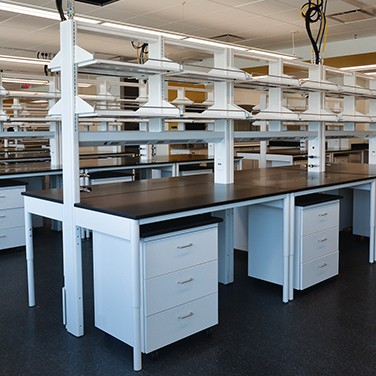Productivity as a Goal in Lab Design and Layout
Laboratory productivity is a function of both an environment that matches the lab’s purpose and one that suits the individuals who will use the space.
Your project may be building a new lab or renovating an older one. Because the useful life of a lab ranges from 10 to 30 years, you’ll want your lab to be a productive and comfortable space for as long as possible. To start, select a team to develop a clear understanding of the project goals. The team should include lab management, personnel, facilities management, a representative from health and safety, and a lab design professional.
Lab productivity also relies on three important elements: design considerations, ergonomics, and adaptability.
Design Considerations
When reviewing your lab needs and requirements, consider:
- The general purpose of each lab, support, or workspace, including:
- Number of people
- Bench space per person or operation
- Number of fume hoods or biological safety cabinets
- The rough amount of laboratory space needed
- The location of the lab(s)
- All lab equipment, including a listing of purpose, location, dimensions, and service requirements
- The current layout and workflow and any modifications needed
- Flexible, open space for possible future needs
- Specific use and storage for:
- Radioactive or biological materials
- Hazardous materials and processes
- ADA compliance
- Rolling equipment access
- Ancillary space needs:
- Sample receipt or work in progress areas
- Glass washing and preparation areas
- Equipment support space
- Offices and desk space
- Lab storage needs:
- General supplies
- Glassware
- Chemicals
- Samples and specimens
- Future and potential revised use for any spaces
Ergonomics
Ergonomics is the science of matching the task, workspace, and tools to the user to reduce musculoskeletal stress. Laboratorians are at risk for developing health issues from the repetitive nature of pipetting, use of small handheld tools, opening and closing vial caps, prolonged awkward postures, and other various laboratory tasks.
Whether you’re working in a laboratory for one semester or throughout your career, you can protect yourself and other personnel from the ergonomic hazards common in laboratory settings. Well-designed and flexible furniture systems and Fisherbrand ergonomic seating can help provide a comfortable, healthy, and productive lab environment.
- Position work surfaces and cabinets at comfortable heights and locations
- Place materials and equipment in easy-to-reach locations on the benchtop
- Keep areas underneath biosafety cabinets free of drawers, supplies, refrigerators, and other items to provide adequate leg room
- Use ergonomically designed chairs that provide back support, adjustable seat angles, and adjustable heights between 28 and 33 inches
- Use seating with adjustable footrests
- Use anti-fatigue matting for areas where personnel stand for extended periods of time
Adaptability
Changes in lab environments are inevitable, and the ability to accommodate changes must be planned. Productivity can be compromised if the lab can’t adapt to new needs, programs, or equipment.
Adaptable laboratory furniture systems can help maintain or increase lab productivity as changes occur. These include modular furniture assemblies with support structures, cabinets, worksurfaces, and other accessories. They allow for adjustability of shelving, cabinetry, worksurfaces, and utilities.
One of the most popular lab furnishing systems is the Class 7 free-standing workstation, defined by the Scientific Equipment Furniture Association (SEFA) as:
“…table-based systems utilizing floor-mounted tables as the key component. The workstation can be worksurface height or incorporate above-counter structure[s]. The workstations can incorporate either adjustable-height or fixed-height worksurfaces. Base cabinets can be mobile, floor mounted, or suspended. Upper cabinets, worksurfaces, shelving, service utility distribution, and ancillary items can be suspended from the frame structure. Free-standing workstations with above-counter structures can be pre-plumbed and pre-wired and used in conjunction with ceiling-mounted service distribution systems. Typically, free-standing workstations incorporate adjustment slots for vertical height adjustability of worksurfaces, shelving, and ancillary items. Free-standing workstations are not anchored to the building, allowing for simple relocation.”
Adaptable laboratory furniture systems can provide the structure and function that you need today while accommodating future changes and updates to your laboratories. Contact your Fisher Scientific sales representative to learn more about Fisherbrand lab furnishings.

